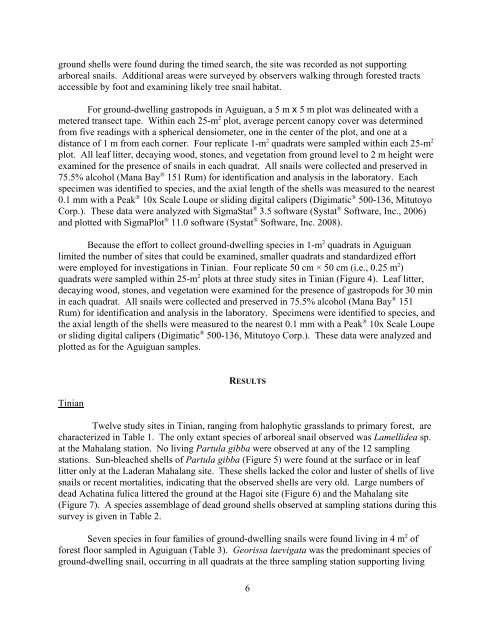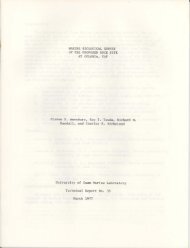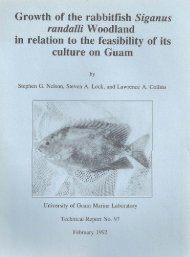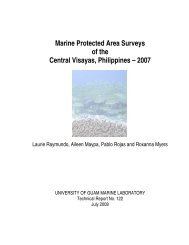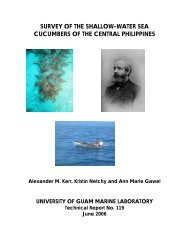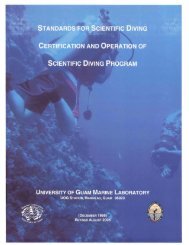Taxonomic inventories and assessments of terrestrial snails on the ...
Taxonomic inventories and assessments of terrestrial snails on the ...
Taxonomic inventories and assessments of terrestrial snails on the ...
Create successful ePaper yourself
Turn your PDF publications into a flip-book with our unique Google optimized e-Paper software.
ground shells were found during <strong>the</strong> timed search, <strong>the</strong> site was recorded as not supporting<br />
arboreal <str<strong>on</strong>g>snails</str<strong>on</strong>g>. Additi<strong>on</strong>al areas were surveyed by observers walking through forested tracts<br />
accessible by foot <str<strong>on</strong>g>and</str<strong>on</strong>g> examining likely tree snail habitat.<br />
For ground-dwelling gastropods in Aguiguan, a 5 m x 5 m plot was delineated with a<br />
metered transect tape. Within each 25-m 2 plot, average percent canopy cover was determined<br />
from five readings with a spherical densiometer, <strong>on</strong>e in <strong>the</strong> center <str<strong>on</strong>g>of</str<strong>on</strong>g> <strong>the</strong> plot, <str<strong>on</strong>g>and</str<strong>on</strong>g> <strong>on</strong>e at a<br />
distance <str<strong>on</strong>g>of</str<strong>on</strong>g> 1 m from each corner. Four replicate 1-m 2 quadrats were sampled within each 25-m 2<br />
plot. All leaf litter, decaying wood, st<strong>on</strong>es, <str<strong>on</strong>g>and</str<strong>on</strong>g> vegetati<strong>on</strong> from ground level to 2 m height were<br />
examined for <strong>the</strong> presence <str<strong>on</strong>g>of</str<strong>on</strong>g> <str<strong>on</strong>g>snails</str<strong>on</strong>g> in each quadrat. All <str<strong>on</strong>g>snails</str<strong>on</strong>g> were collected <str<strong>on</strong>g>and</str<strong>on</strong>g> preserved in<br />
75.5% alcohol (Mana Bay ® 151 Rum) for identificati<strong>on</strong> <str<strong>on</strong>g>and</str<strong>on</strong>g> analysis in <strong>the</strong> laboratory. Each<br />
specimen was identified to species, <str<strong>on</strong>g>and</str<strong>on</strong>g> <strong>the</strong> axial length <str<strong>on</strong>g>of</str<strong>on</strong>g> <strong>the</strong> shells was measured to <strong>the</strong> nearest<br />
0.1 mm with a Peak ® 10x Scale Loupe or sliding digital calipers (Digimatic ® 500-136, Mitutoyo<br />
Corp.). These data were analyzed with SigmaStat ® 3.5 s<str<strong>on</strong>g>of</str<strong>on</strong>g>tware (Systat ® S<str<strong>on</strong>g>of</str<strong>on</strong>g>tware, Inc., 2006)<br />
<str<strong>on</strong>g>and</str<strong>on</strong>g> plotted with SigmaPlot ® 11.0 s<str<strong>on</strong>g>of</str<strong>on</strong>g>tware (Systat ® S<str<strong>on</strong>g>of</str<strong>on</strong>g>tware, Inc. 2008).<br />
Because <strong>the</strong> effort to collect ground-dwelling species in 1-m 2 quadrats in Aguiguan<br />
limited <strong>the</strong> number <str<strong>on</strong>g>of</str<strong>on</strong>g> sites that could be examined, smaller quadrats <str<strong>on</strong>g>and</str<strong>on</strong>g> st<str<strong>on</strong>g>and</str<strong>on</strong>g>ardized effort<br />
were employed for investigati<strong>on</strong>s in Tinian. Four replicate 50 cm × 50 cm (i.e., 0.25 m 2 )<br />
quadrats were sampled within 25-m 2 plots at three study sites in Tinian (Figure 4). Leaf litter,<br />
decaying wood, st<strong>on</strong>es, <str<strong>on</strong>g>and</str<strong>on</strong>g> vegetati<strong>on</strong> were examined for <strong>the</strong> presence <str<strong>on</strong>g>of</str<strong>on</strong>g> gastropods for 30 min<br />
in each quadrat. All <str<strong>on</strong>g>snails</str<strong>on</strong>g> were collected <str<strong>on</strong>g>and</str<strong>on</strong>g> preserved in 75.5% alcohol (Mana Bay ® 151<br />
Rum) for identificati<strong>on</strong> <str<strong>on</strong>g>and</str<strong>on</strong>g> analysis in <strong>the</strong> laboratory. Specimens were identified to species, <str<strong>on</strong>g>and</str<strong>on</strong>g><br />
<strong>the</strong> axial length <str<strong>on</strong>g>of</str<strong>on</strong>g> <strong>the</strong> shells were measured to <strong>the</strong> nearest 0.1 mm with a Peak ® 10x Scale Loupe<br />
or sliding digital calipers (Digimatic ® 500-136, Mitutoyo Corp.). These data were analyzed <str<strong>on</strong>g>and</str<strong>on</strong>g><br />
plotted as for <strong>the</strong> Aguiguan samples.<br />
Tinian<br />
RESULTS<br />
Twelve study sites in Tinian, ranging from halophytic grassl<str<strong>on</strong>g>and</str<strong>on</strong>g>s to primary forest, are<br />
characterized in Table 1. The <strong>on</strong>ly extant species <str<strong>on</strong>g>of</str<strong>on</strong>g> arboreal snail observed was Lamellidea sp.<br />
at <strong>the</strong> Mahalang stati<strong>on</strong>. No living Partula gibba were observed at any <str<strong>on</strong>g>of</str<strong>on</strong>g> <strong>the</strong> 12 sampling<br />
stati<strong>on</strong>s. Sun-bleached shells <str<strong>on</strong>g>of</str<strong>on</strong>g> Partula gibba (Figure 5) were found at <strong>the</strong> surface or in leaf<br />
litter <strong>on</strong>ly at <strong>the</strong> Laderan Mahalang site. These shells lacked <strong>the</strong> color <str<strong>on</strong>g>and</str<strong>on</strong>g> luster <str<strong>on</strong>g>of</str<strong>on</strong>g> shells <str<strong>on</strong>g>of</str<strong>on</strong>g> live<br />
<str<strong>on</strong>g>snails</str<strong>on</strong>g> or recent mortalities, indicating that <strong>the</strong> observed shells are very old. Large numbers <str<strong>on</strong>g>of</str<strong>on</strong>g><br />
dead Achatina fulica littered <strong>the</strong> ground at <strong>the</strong> Hagoi site (Figure 6) <str<strong>on</strong>g>and</str<strong>on</strong>g> <strong>the</strong> Mahalang site<br />
(Figure 7). A species assemblage <str<strong>on</strong>g>of</str<strong>on</strong>g> dead ground shells observed at sampling stati<strong>on</strong>s during this<br />
survey is given in Table 2.<br />
Seven species in four families <str<strong>on</strong>g>of</str<strong>on</strong>g> ground-dwelling <str<strong>on</strong>g>snails</str<strong>on</strong>g> were found living in 4 m 2 <str<strong>on</strong>g>of</str<strong>on</strong>g><br />
forest floor sampled in Aguiguan (Table 3). Georissa laevigata was <strong>the</strong> predominant species <str<strong>on</strong>g>of</str<strong>on</strong>g><br />
ground-dwelling snail, occurring in all quadrats at <strong>the</strong> three sampling stati<strong>on</strong> supporting living<br />
6


